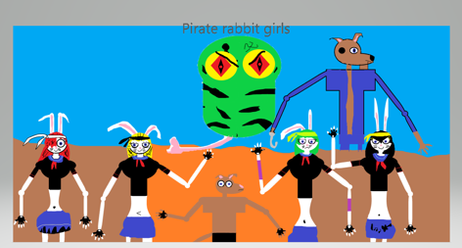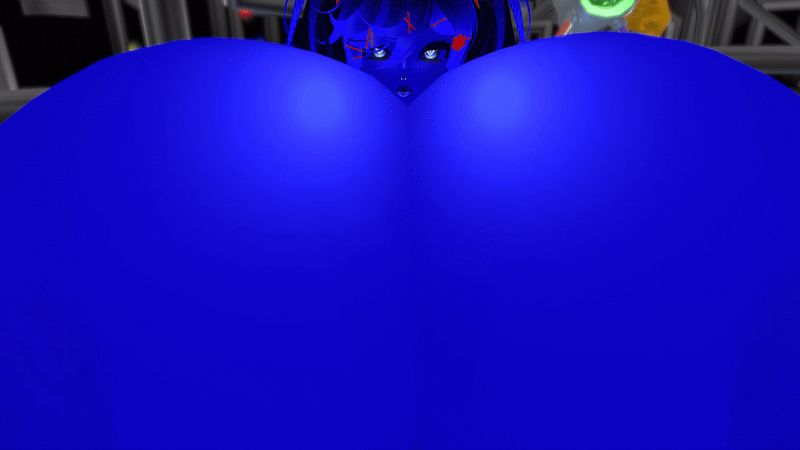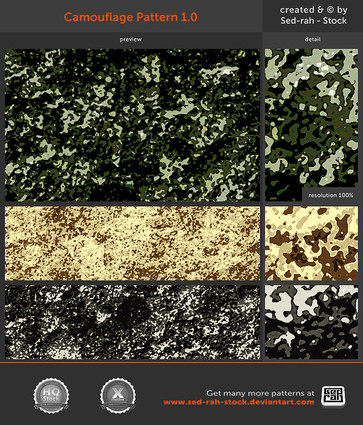HOME | DD
 Tounushi — m09 Digital Pattern chart
Tounushi — m09 Digital Pattern chart

Published: 2009-04-11 23:05:55 +0000 UTC; Views: 12843; Favourites: 32; Downloads: 24
Redirect to original
Description
Finally got it done.This is the color scheme chart for the m/09 Digital Pattern. All the environmental camouflages are in full scale and have been accordingly labeled. The samples only contain a small slice of the full tile (which measures at one square meter). The full pattern tile is displayed at the lower right corner.
-Air Force pattern is used by air force personnel as their default color scheme on their NCU s and flight suits .
-Arctic Snow is used on snow gear and is used in winter environments, where snow is prevalent.
-Amphibious is used in swamplands, river deltas and other waterlogged or otherwise wet areas.
-Desert is used in arid and semi-arid environments.
-Marine camouflage is used by the Republic Colonial Marine Corps as their default scheme. Serves well in temperate and lightly forested areas.
-Navy serves as the default scheme of the Republic Stellar Navy. Used on navy NCU s.
-NCU is the default scheme for the Republic Grand Army, serving in temperate, sub-tropical, light urban and lightly forested environments.
-Cold Weather NCU is a spring/fall version of the NCU, where green has been replaced with light grey, simulating light-to-medium snow cover.
-Ninja is the default camo of the Republic Special Service, serving as a primarily night-time camouflage.
-Urban is used in medium-to-heavy urban environments and installations.
-Woodland is meant for densely forested areas.
==============EDIT 29.07.2009==============
Readjusted the scale of the digital pattern to 10px/25mm.
Related content
Comments: 12

Nice dude !!!! you need to check out mine if you want
👍: 0 ⏩: 0

NP. The navy colors are based on the USN NWU colors, anyway.
👍: 0 ⏩: 0

Don't you think that cold weather pattern with white replaced with light grey can be suitable to urban enviroment? Cities aren't all grey, building have color, or brick elevations etc...
👍: 0 ⏩: 1

The urban pattern is meant for a modern concrete jungle. Even though it doesn't have many large straight shapes, it should function reasonably well in an urban environment. It is more economical to swap colors on a single pattern than to design multiple patterns for ever conceivable environment.
👍: 0 ⏩: 0

==========EDIT==========
Replaced my signature (IRL signature) with the kanji corresponding my name.
👍: 0 ⏩: 0

By the way, how did you make the patterns themselves? I'm trying to put together my own uniform template, so that's why I ask.
👍: 0 ⏩: 1

I originally doodled my m/07 pattern a few years ago. I drew random shapes in different layers in photoshop, then applied the PS magic. crystallize and facet. That gave me my original pattern. the modifications thereof were manually done. Painstakingly. M/08 was an effort to extend the pattern, as I noticed it repeated too often. With m/08 there were two versions: polygon and pixel. I noticed there wasn't much difference between the two when zoomed out, so I decided to make a new pattern.
I was inspired by the Columbian Pixelado and the Chinese M07 patterns, but I wanted to maintain some true pattern. Perhaps some inspiration came also from the flecktarn.
So I basically drew over my m/08 using spray pattern brushes. After that it was rearranging the layers, making sure the pattern repeated properly and some minor tweaks to go. After that it was resizing (shrinking, expanding, stretching) the image in indexed colors, so the pattern became slightly distorted. At some point I just decided "this'll do."
Nowadays most professional (and many amateur) camoufleurs use mathematics to make the patterns, using fractal designs. I just went with the older artistic route. I just made a pattern that pleased my eye.
Of course, I know now much more about camouflage and crypsis than I did in '06. I learned much during the army, and afterwards through the internet. A few good sites to scope out are camo central and hyperstealth .
Also to note: If you want to make traditional patterns (US woodland, Flecktarn, Tigerstripe, Leibermuster, etc.), use a vector graphics program, as the shapes will not become distorted by resizing as a raster image; and digital/pixel camo as raster/bitmap images, as the pixels will remain as pixels. And with vector graphics you can easily resize a camo tile or a sheet of tiles.
👍: 0 ⏩: 0

Replacing the brighter purples with a dark grey (to blend in with low-light 'gray-out' experienced by the human eye) would be better for Ninja; black sticks out at night. The almost pure-white of Arctic will stand out in snow as well (although that sounds pretty counter-intuitive); adding more of that light grey and putting in a medium grey would help.
👍: 0 ⏩: 1

I had to give some contrast so the pattern would retain its disruptive properties. And the human eye can't pick up colors worth anything at night, except maybe a bit of blue. And the black is for depth. The camo isn't for full darkness (what would be the point in that case), but in low-light conditions. Black is the simulation of depth and shadows. Also the camo is more effective in IR.
👍: 0 ⏩: 0





























